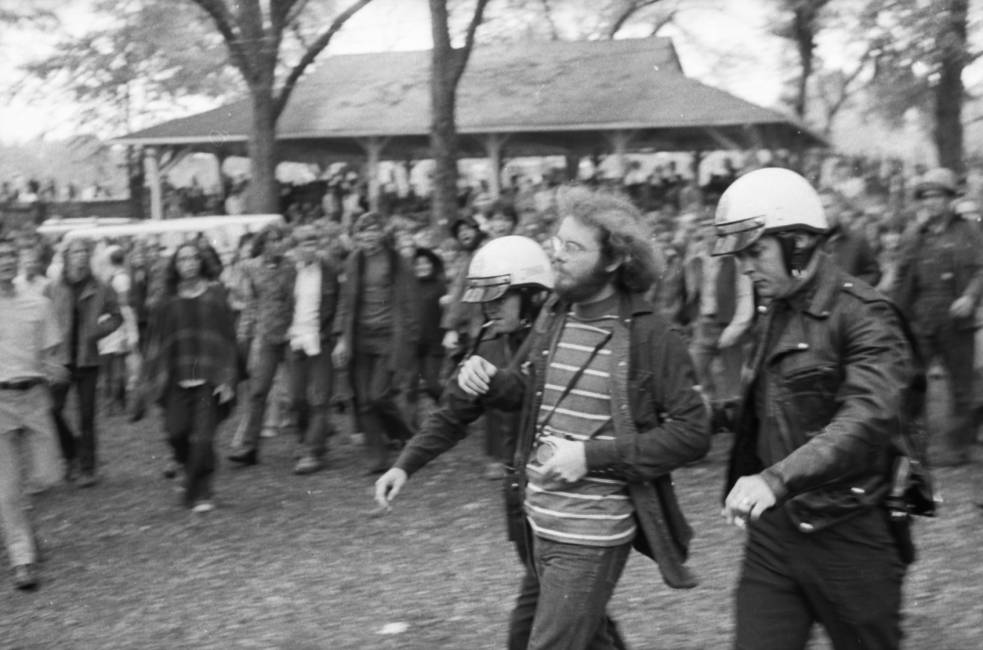
By Christopher Huff
In the summer of 1967, Atlanta Journal reporter Michael Palmer went undercover as a hippie. Hoping to provide his readers with some insight into a movement that had recently made its way into the national consciousness, Palmer put on a “white, ruffled shirt, and old vest, levies [sic] frayed at the cuffs” and stealthily entered the city’s small but noticeable hippie community. In a series of articles that followed this experience, Palmer discussed with a mixture of dismissal and despair what he encountered during his five weeks of undercover research – from watching people take drugs in a “crash pad” to participating in a “love-in” at Piedmont Park. While Palmer ultimately provided little real insight into the countercultural mindset, he did make his readers very aware that something new and different was happening in Midtown Atlanta.1

POLICE PERFORMING A NIGHTTIME ANTI-DRUG RAID AGAINST HIPPIES, ATLANTA, GEORGIA, AUGUST 4, 1969. V003-600001-A24, TOM COFFIN PHOTOGRAPHS. SPECIAL COLLECTIONS AND ARCHIVES, GEORGIA STATE UNIVERSITY LIBRARY. COURTESY GEORGIA STATE UNIVERSITY.

INSPECTING THE DAMAGE: “ATLANTIS RISING BOMBING,” ATLANTA, GEORGIA, SEPTEMBER 11, 1969. V003-690911-A28, TOM COFFIN PHOTOGRAPHS. SPECIAL COLLECTIONS AND ARCHIVES, GEORGIA STATE UNIVERSITY LIBRARY. COURTESY GEORGIA STATE UNIVERSITY.
OUR PARK

VIETNAM WAR PROTEST. METRO ATLANTA CHAMBER OF COMMERCE COLLECTION AT KENAN RESEARCH CENTER AT ATLANTA HISTORY CENTER. COURTESY ATLANTA HISTORY CENTER.

HIPPIE DRUM CIRCLE IN PIEDMONT PARK, ATLANTA, GEORGIA, CIRCA 1969. TOM COFFIN PHOTOGRAPHS. SPECIAL COLLECTIONS AND ARCHIVES, GEORGIA STATE UNIVERSITY LIBRARY. COURTESY GEORGIA STATE UNIVERSITY.
if we are a revolutionary culture then we must . . . refuse festivals and radio and recordings . . . musicians will play, will fill our parks, because they must play, and we will listen because we must and there will be no one in between.
you will come to the park to make it your park and you will listen to music and know that it is your music and it will be freedom.

PEOPLE EATING AT A FREE CONCERT SPONSORED BY THE “GREAT SPECKLED BIRD” AT PIEDMONT PARK, ATLANTA, GEORGIA, SEPTEMBER 21, 1969. TOM COFFIN PHOTOGRAPHS. SPECIAL COLLECTIONS AND ARCHIVES, GEORGIA STATE UNIVERSITY LIBRARY. COURTESY GEORGIA STATE UNIVERSITY.
The vibes in Piedmont Park on all the Saturdays and Sundays flow out of our fight to replace the power behind the firebomb . . . that gutted Atlantis Rising, and our attempt to design a politics to effect that replacement.
“GET THE PIGS OUT OF OUR PARK!”

ONE OF THE BANDS PERFORMING AT A “GREAT SPECKLED BIRD” CONCERT IN PIEDMONT PARK, ATLANTA, GEORGIA, SEPTEMBER 21, 1969. V003-600001-C27, TOM COFFIN PHOTOGRAPHS. SPECIAL COLLECTIONS AND ARCHIVES, GEORGIA STATE UNIVERSITY LIBRARY. COURTESY GEORGIA STATE UNIVERSITY.
if your hair is long and you’re wearing bell-bottoms you are in for it. Girls are jerked and pulled into line by their hair . . . and they {officers} seem to delight in grabbing a man by the seat of his pants and lifting him up until the pressure in his groin becomes unbearable.

“GREAT SPECKLED BIRD” PHOTOGRAPHER BILL FIBBEN BEING ARRESTED DURING A BOTCHED POLICE OPERATION DURING A CONCERT IN PIEDMONT PARK, ATLANTA, GEORGIA, SEPTEMBER 21, 1969. V003-600001-C35, TOM COFFIN PHOTOGRAPHS. SPECIAL COLLECTIONS AND ARCHIVES, GEORGIA STATE UNIVERSITY LIBRARY. COURTESY GEORGIA STATE UNIVERSITY.

TEAR GAS UNLEASHED ON HIPPIES ATTENDING A FOLK CONCERT IN PIEDMONT PARK, ATLANTA, GEORGIA, SEPTEMBER 22, 1969. PHOTO BY NOEL DAVIS. AJCP211-032A, ATLANTA JOURNAL-CONSTITUTION PHOTOGRAPHIC ARCHIVES. SPECIAL COLLECTIONS AND ARCHIVES, GEORGIA STATE UNIVERSITY LIBRARY. COPYRIGHT ATLANTA JOURNAL-CONSTITUTION. COURTESY GEORGIA STATE UNIVERSITY.
RESPONSES TO THE RIOT

POLICEMEN DRAGGING A YOUNG HIPPIE THROUGH THE GRASS, PIEDMONT PARK, ATLANTA, GEORGIA, SEPTEMBER 22, 1969. PHOTO BY NOEL DAVIS. AJCP211-032B, ATLANTA JOURNAL-CONSTITUTION PHOTOGRAPHIC ARCHIVES. SPECIAL COLLECTIONS AND ARCHIVES, GEORGIA STATE UNIVERSITY LIBRARY. COPYRIGHT ATLANTA JOURNAL-CONSTITUTION. COURTESY GEORGIA STATE UNIVERSITY.

HIPPIES TALK TO MAYOR IVAN ALLEN JR. AFTER THE RIOT. FROM: GREAT SPECKLED BIRD 2, NO. 29 (SEPTEMBER 29, 1969), 22. GREAT SPECKLED BIRD COLLECTION. SPECIAL COLLECTIONS AND ARCHIVES, GEORGIA STATE UNIVERSITY LIBRARY. COURTESY GEORGIA STATE UNIVERSITY.
Sunday’s resistance was not ‘revolutionary antics,’ the work of ‘agitators.’ Sunday was a defense of the kind of life we have chosen to live. This life includes music; it includes dope; but more significantly; and of revolutionary impact, is our self-perception as a people acting in unity.
A park cannot be liberated by permit, cannot be ‘free’ just because freaks come together to dig some fine music . . . Sunday was about what comes down when . . . we transgress the constricted lifestyle that is acceptable to and in this rotten society.
this is the same thing that has been happening to black people for a long time – and partly for the same reason: because they don’t want to conform to the ways of this sick, racist society. The reason they’re brutalizing you is simple: you want to live your own life, your own way.

THE GREAT SPECKLED BIRD 2, NO. 29 (SEPTEMBER 29, 1969), 3. GREAT SPECKLED BIRD COLLECTION. SPECIAL COLLECTIONS AND ARCHIVES, GEORGIA STATE UNIVERSITY LIBRARY. COURTESY GEORGIA STATE UNIVERSITY.

YOUNG PEOPLE MARCH IN PROTEST AGAINST POLICE TACTICS AFTER A “GREAT SPECKLED BIRD” SPONSORED CONCERT, ATLANTA, GEORGIA, SEPTEMBER 27, 1969. V003-690927-A08, TOM COFFIN PHOTOGRAPHS. SPECIAL COLLECTIONS AND ARCHIVES, GEORGIA STATE UNIVERSITY LIBRARY. COURTESY GEORGIA STATE UNIVERSITY.
WHERE DID ALL THE HIPPIES GO?
police and state solicitor general’s agents, with the tacit approval of the city administration and Atlanta’s business community, have waged war against these so-called undesirables, treating them as the greatest threat to the city since General Sherman.

MOUNTED PATROL IN PIEDMONT PARK. BOYD LEWIS COLLECTION AT KENAN RESEARCH CENTER AT THE ATLANTA HISTORY CENTER. COURTESY ATLANTA HISTORY CENTER.

Leave a Reply